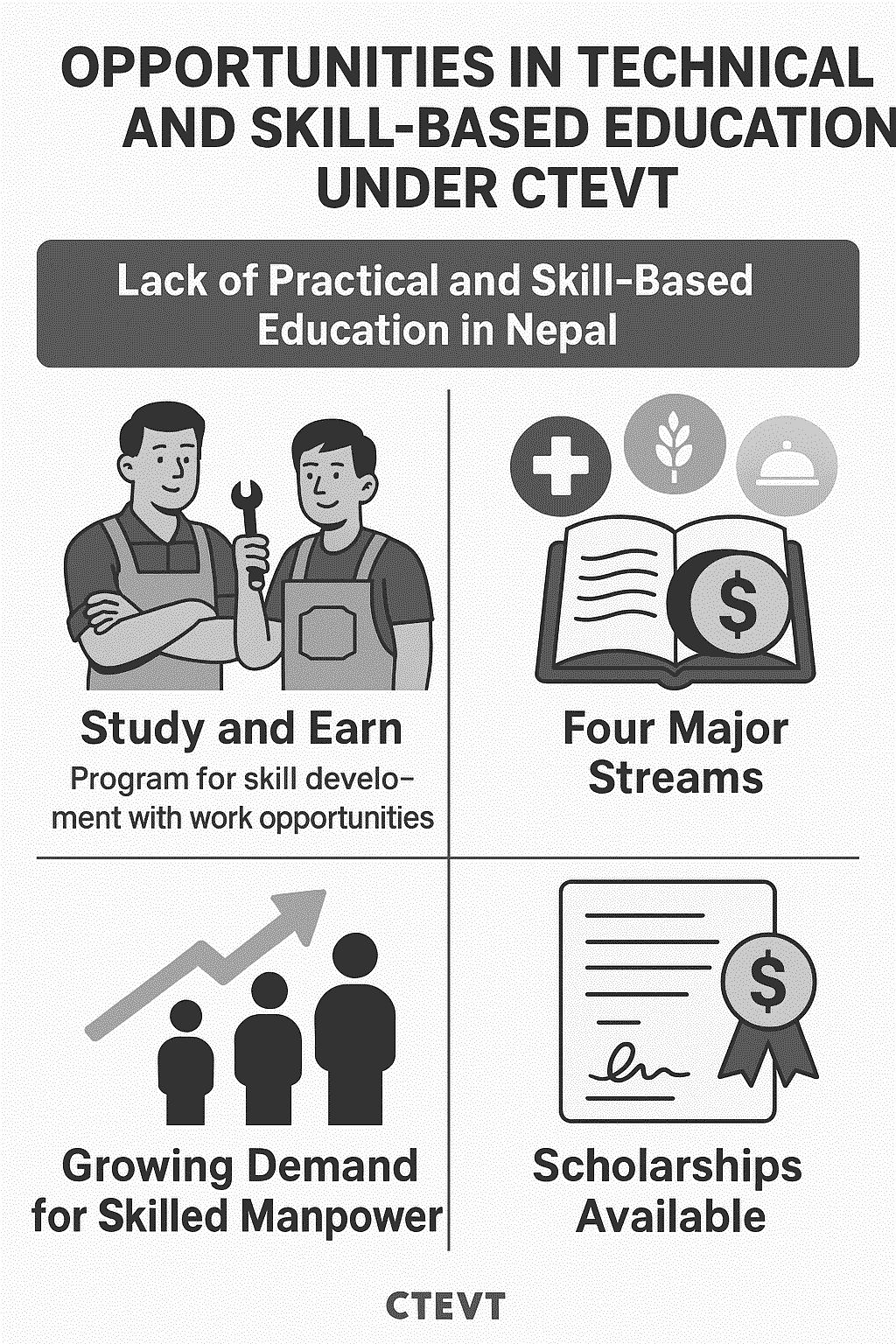
Opportunities in Technical and Skill-Based Education Under CTEVT
In recent times, there has been intense discussion in Nepal about the lack of life-skill and vocational education. The increasing number of students leaving for employment or higher studies abroad confirms this concern. However, the success stories of individuals show that it is possible to study and earn within the country as well.
One such example is Basanta Chaudhary from Rajapur, Bardiya. While studying at Panauti Technical School under the Council for Technical Education and Vocational Training (CTEVT), he started earning an income.
He is pursuing a two-year pre-diploma in Industrial Auto Mechanical Engineering and currently works at Rocket Sales, an automobile workshop in Gaushala, Kathmandu, earning NPR 40,000 per month. After experiencing hardships during his foreign employment after grade 12, he regrets not having chosen this path earlier.
Similarly, Pramod Parajuli, also enrolled in the same course, has been earning for about one and a half years while learning. He works at Continental Training in Balaju, Kathmandu, earning over NPR 30,000 monthly. A scholarship recipient, he shared, “Once I receive my automobile engineering certificate, I won’t need to go abroad to earn NPR 100,000 per month.”
These individuals are just examples. Since its establishment, the institution has produced thousands of skilled workers. According to Deputy Head Mrigendrah Pradhan, Panauti Technical School—an autonomous institution under CTEVT—has been running Pre-Diploma in Automobile Engineering since 2055 BS and Diploma in Automobile Engineering since 2078 BS.
Concept of Study and Earn
To make trainees entrepreneurial and skilled, the "Study and Earn" program offers opportunities like those for Basanta and Pramod. CTEVT’s annual report states that 78% of certified graduates from the automobile engineering course have secured employment. The program enhances not only skills and confidence but also develops the ability to identify community needs, solve problems, generate income, market services, and maintain professionalism.
CTEVT has also established a Business Incubation Centre to support current students, alumni, and those interested in entrepreneurship by identifying their interests and capabilities.
Stream Selection Under CTEVT
CTEVT offers academic programs in four major streams: Health, Agriculture, Hospitality, and Engineering. Students planning a career in any of these sectors can choose relevant courses accordingly. CTEVT was founded to produce technically skilled manpower to meet national and market demands.
Director Tailendra Acharya emphasized that CTEVT is focused on producing skilled human resources tailored to market needs. According to him, the skills learned here help youth secure employment both within Nepal and abroad.
Growing Demand for Skilled Technical Manpower
A 2022 labor market analysis by CTEVT projected that by 2030, Nepal will require hundreds of thousands of skilled workers in the health, agriculture, construction, and tourism sectors.
-
Over 600,000 in agriculture
-
Over 600,000 in Construction
-
100,000 in health
-
200,000 in tourism
This data reflects the urgent need for skill-based technical education. With the right training at the right time, young people can seize numerous employment opportunities within Nepal. The government must now focus on expanding the accessibility, quality, and effectiveness of technical education programs.
CTEVT Courses Across 1,182 Institutions
CTEVT operates pre-diploma (18-month) and two-year programs in Engineering, Computer Applications, and Secretarial Management. Diploma-level (three-year) programs include Automobile Engineering, Computer Engineering, and Information Technology.
These programs run across:
-
66 autonomous institutions
-
55 partnership institutions
-
639 community schools (TECS schools)
-
422 private affiliated institutions
Altogether, CTEVT courses are offered in 1,182 institutions nationwide.
Only 52% of Enrollment Capacity Fulfilled
According to the annual report, only 52% of the total admission capacity is being filled. Out of 69,493 available seats, only 36,031 students were enrolled in pre-diploma and diploma programs.
-
Diploma: 27,390 enrolled out of 42,671 capacity
-
Pre-diploma: 8,641 enrolled out of 26,822 capacity
Scholarships and Fee Structure
Every year, CTEVT provides scholarships for various programs at both diploma and pre-diploma levels. This year, a total of 3,697 students will receive full scholarships:
-
Diploma: 3,047 students
-
Pre-diploma: 651 students
The cost of studying CTEVT programs typically ranges from NPR 15,000 to NPR 500,000, depending on the course.
Difference Between Pre-Diploma and Diploma
The pre-diploma is an 18-month course with 15 months of theory and 3 months of practical training. SEE results are not a factor for admission into pre-diploma programs.
The diploma is a three-year (six-semester) course. Minimum requirements include a GPA of 2.0 in SEE:
-
Health Programs: At least ‘C’ grade in Math, Science, and English
-
Engineering Programs: At least ‘C’ in Math and Science and ‘D+’ in English
-
Agriculture and Hospitality: Minimum ‘C’ in any two of Math, Science, or English, and at least ‘D+’ in one subject
Graduates of pre-diploma programs are not eligible for admission to bachelor 's-level programs unless they were enrolled in +2 during their training. Diploma graduates can easily pursue a bachelor's degree program.
High Employability After Technical Education
Nirmal Prasad Sapkota, General Secretary of the Health and Technical Forum, stated that most students who complete technical education secure jobs. Given the labor market demand for skilled workers, CTEVT courses equip students with market-relevant skills, ensuring they are not left unemployed after completing their education.


